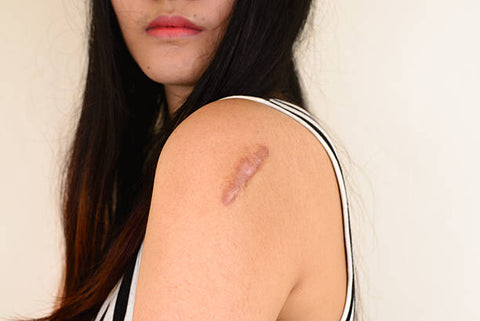What are Lesions?
Lesions are changes in the body's soft tissue that can take many forms. They can range from small cuts and scratches to large, open wounds. Lesions can be caused by a variety of things, including viruses, bacteria, fungi, and other parasites. Lesions can also be caused by physical trauma, such as cuts, scrapes, and burns. Lesions can also be caused by medical conditions, such as cancer, autoimmune disorders, and infections. The size, shape, and color of a lesion can provide important clues to a medical professional about the cause of the lesion and the best course of treatment.
When a lesion is present, it is important to seek medical attention to determine the cause and the best course of action. Lesions can be a sign of various types of injury or disease. It is also important to keep an eye out for any changes in the size, shape, or color of a lesion.
In some cases, lesions may require treatment such as antibiotics, surgery, or other interventions to help the body heal. In other cases, lesions may heal on their own with proper care and hygiene.
It is important to note that not all lesions are a sign of injury or disease. Some lesions may be benign, such as moles or skin tags, and do not require any treatment.
No matter the cause, it is important to seek medical advice if you have any concerns about a lesion. With proper diagnosis and treatment, many lesions can be addressed quickly and effectively.
What are the main causes of Lesions?

Recent research on lesions has focused on the role of lesions in various diseases. For example, research has investigated the role of lesions in neurological disorders such as Alzheimer's disease and Parkinson's disease. Additionally, researchers have studied the role of lesions in cardiovascular diseases, cancer, and autoimmune diseases such as lupus. Research has also looked into the use of imaging techniques such as magnetic resonance imaging (MRI) to detect and diagnose lesions. Finally, research has explored the potential use of lesions to treat various conditions, such as using laser ablation to treat cancer.
Some Causes of Lesions may include:
1. Trauma: Trauma is the most common cause of lesions. This includes physical trauma, such as cuts, scrapes, burns, or bruises, as well as trauma resulting from medical treatments, such as surgery, radiation therapy, or chemotherapy.
2. Infections: Bacterial, viral, and fungal infections can all lead to lesions. Common causes of infection-related lesions include chickenpox, cold sores, and acne.
3. Autoimmune disorders: Autoimmune disorders are when the body’s immune system mistakenly attacks healthy tissues. This can lead to lesions on the skin, as well as other organs. Examples include lupus and psoriasis.
4. Skin conditions: Certain skin conditions can lead to the development of lesions. These include eczema, contact dermatitis, and rosacea.
5. Tumors: Tumors, both cancerous and non-cancerous, can cause lesions. These may be visible as lumps or bumps on the skin.
Symptoms
Are you noticing lesions on your skin? Lesions can be a sign of many different medical conditions, ranging from benign to serious. In this blog, we’ll discuss some of the common symptoms associated with lesions so you can be more aware of your health.
1. Itching: One of the most common symptoms of lesions is itching. If you experience intense itching around a lesion, it could be an indication of a more serious medical condition.
2. Pain: Lesions can be painful, particularly if they become infected or inflamed. If you experience a sharp, throbbing, or burning sensation around a lesion, it could be a sign of something serious.
3. Swelling: Swelling is another common symptom of lesions. If you notice a lesion is getting larger or is accompanied by swelling, it could be a sign of an infection or underlying medical condition.
4. Redness: Redness around a lesion can be a sign of inflammation or infection. If the redness spreads or worsens, it could be a sign of something more serious.
5. Discharge: If a lesion is oozing or producing a discharge, it could be a sign of an infection. If you notice a discharge around a lesion, it’s important to see a doctor as soon as possible.
Treatments for lesions

1. Surgical Excision: Surgical excision is a common treatment for lesions, especially cancerous lesions. The lesion is surgically removed, and any surrounding tissue that may be affected is also removed to minimize the risk of recurrence.
2. Cryotherapy: Cryotherapy uses freezing temperatures to kill cancer cells. It can be used to treat lesions on the skin, as well as lesions on the internal organs.
3. Laser Therapy: Laser therapy involves using a high-energy laser beam to destroy cancer cells. It can be used to treat lesions on the skin, as well as lesions on the internal organs.
4. Radiation Therapy: Radiation therapy uses high-energy radiation to kill cancer cells. It can be used to treat lesions on the skin, as well as lesions on the internal organs.
5. Hormone Therapy: Hormone therapy uses hormones to slow or stop the growth of cancer cells. It can be used to treat lesions on the skin, as well as lesions on the internal organs.
6. Immunotherapy: Immunotherapy uses the body’s own immune system to fight cancer cells. It can be used to treat lesions on the skin, as well as lesions on the internal organs.
Causes of Brain Lesions
Brain lesions are areas of tissue damage or abnormal tissue that can be caused by a variety of conditions. Lesions can occur in any part of the brain and can range from minor to severe. They can be caused by stroke, trauma, infection, or tumor, and can cause a variety of symptoms depending on the location and severity of the lesion.

Stroke is a leading cause of brain lesions. A stroke occurs when a clot or other obstruction blocks a blood vessel in the brain, cutting off the blood supply to the affected area. This can lead to tissue death, which presents as a lesion. Symptoms of a stroke-related lesion can range from mild to severe, depending on the location and size of the lesion. Common symptoms include paralysis, numbness, difficulty speaking, and difficulty understanding.
Traumatic brain injury (TBI) can also lead to lesions in the brain. TBI can be caused by a blow to the head, such as from a car accident or a fall. Lesions caused by TBI can range from minor to severe and can cause a variety of symptoms, depending on the location and severity of the lesion. Common symptoms include headaches, dizziness, confusion, memory loss, and difficulty concentrating.
Infections can also lead to lesions in the brain. Common infections that can cause brain lesions include meningitis, encephalitis, and Lyme disease. Symptoms of infection-related lesions can range from mild to severe, depending on the location and severity of the lesion. Common symptoms include fever, headache, confusion, muscle weakness, and seizures.
Tumors can also lead to brain lesions. Tumors can be cancerous or noncancerous and can range from small to large. Symptoms of tumor-related lesions can range from mild to severe, depending on the location and size of the lesion. Common symptoms include headaches, seizures, and changes in mental or physical abilities.
Brain lesions can cause a variety of symptoms and can have serious implications for a person’s health. If you experience any of the symptoms associated with brain lesions, it is important to seek medical attention as soon as possible. Early diagnosis and treatment can help minimize the damage caused by the lesion and help improve outcomes.












